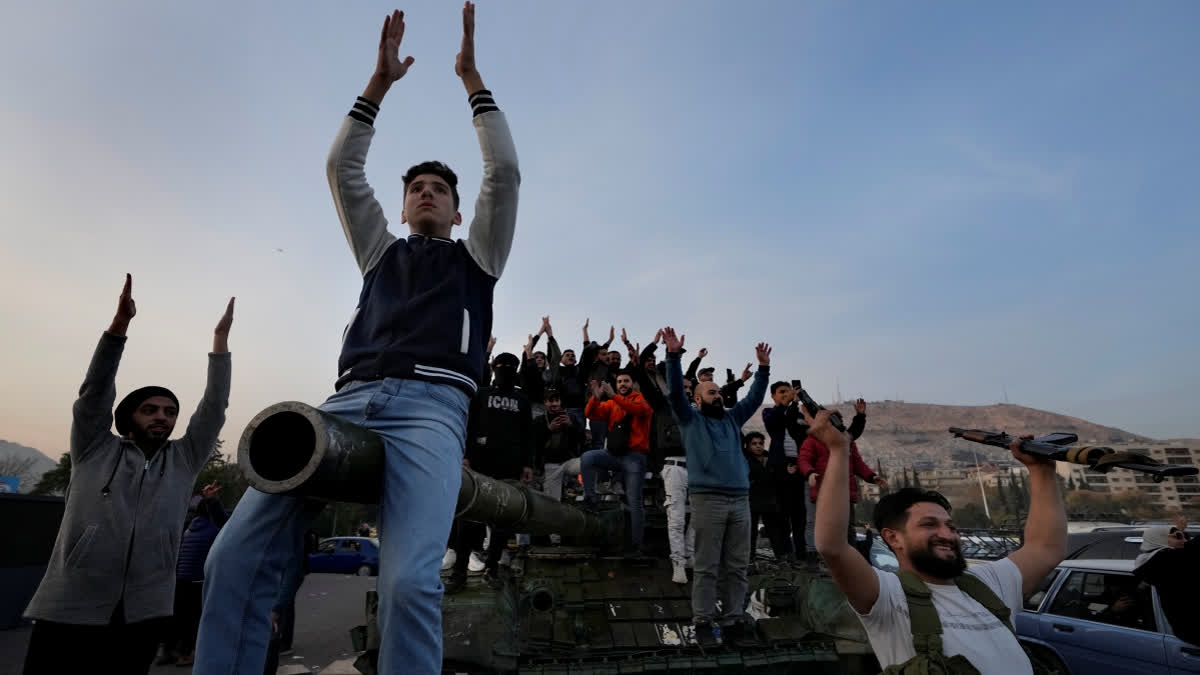The fall of Damascus is reminiscent of the collapse of Kabul, Dhaka, and Colombo where heads of the states were forced to leave their countries similar to how Bashar Al Assad fled Syria to seek refuge in Russia.
The long and bloody conflict between the Assad regime and armed groups came to an end with the collapse of the Syrian government on December 8 as armed resistance groups took over Damascus, forcing Assad to slip away to Russia where his longtime ally Vladimir Putin granted him asylum.
The present situation in Syria, on the face of it, can be compared to Sri Lanka and Bangladesh, where large-scale rallies overthrew the governments and student leadership assumed control of the country, or Afghanistan where the Doha Accord resulted in the Taliban's takeover of the embattled country.
A closer look, however, showcases how the conflict has broader contours and is not just a fight of a people against a 'tyrant' ruler. Syrian resistance was a follow-up of the mass uprising of 2011 which turned violent after the Assad regime muzzled the uprising with an iron hand. Protesters were sent to jail and tortured, and a lot of them vanished without a trace.
Many of the agitators took up arms against the regime, most of them former soldiers. Members of Al-Qaeda joining the resistance forces painted the movement as terrorism leaving less scope for the Syrian resistance to have open support from neighbouring countries. Amid this, several powerful nations attempted to showcase their dominance in the Middle East as they fuelled armed groups with military equipment.
File photo of Bashar Al-Assad, who fled Syria and was replaced by Mohammed al-Bashir for the time-being (AP Photo) The powers that fueled the struggle against Israel were the Assad dictatorship, Lebanese Hezbollah, and Iranian Revolutionary Guards. Under the Assad regime, things remained grim in Syria, especially after the Israel-Hamas conflict, which had a severe impact on both the Lebanese economy and the economy of Iran, a major supporter of anti-Israel resistance in West Asia.
Because Assad was unable to pay salaries to his military troops after falling victim to the Hamas battle, opposition groups gained strength and launched a coordinated strike. Assad was forced to flee after more than 50 years of dynasty rule due to a unified offensive from all sides, beginning from Aleppo, Idlib, continuing through Sama and finally controlling Damascus. Opposition forces while taking over Syria last week faced either no or very little resistance. The biggest armed group in the country was HTS (Hayat Tahrir Al Sham) which took control of the major military installations of the nation including Damascus.
File photo of Mohammad Yunus, who took over the reins from Sheikh Hasina in Bangladesh (IANS) Given how things have unfolded in Syria and the West's reaction to it, one could argue the situation offers a strategic advantage to the West in the Middle East as Iran seems to be at the receiving end. The fall of the Assad regime is a body blow to the Axis of Resistance, Tehran's decades-long strategy to support militant groups and proxies around the region. Syria under Assad was a key player in supporting whatever was required to keep the resistance against Israel rolling in the entire West Asia.
Taliban fighters take control of the Afghan presidential palace after Afghan President Ashraf Ghani fled the country, in Kabul (AP Photo) Damascus maintained a major link between the IRG and Hezbollah and the Assad regime. Iran's decision to support Assad against the popular uprising was a flawed game despite knowing his despotic way of governing the country. Iran and Hezbollah were perceived as being supporters of the tyranny that Assad's rule inflicted on the Syrians while muzzling the resistance. The civilian population became the collateral damage which dented the credibility of the IRG that earlier were seen as 'saviours' of West Asia resistance fighters.
The Palestine cause appeared to be a split between Sunni and Shia nations after Iran showed overwhelming and unconditional support to the Assad dictatorship. Shia nations surrounding Israel were active against Israeli forces while Arabs particularly Sunni countries demonstrated limited support for the Palestine cause. Israel and the US gauged the situation, and opted for a flexible approach towards HTS leadership similar to what they did with the Taliban leadership, despite both being earlier in their most wanted list of terrorism.
Joe Biden, in a statement immediately after Damascus fell to HTS, said the US was closely watching the situation in Syria and hinted at HTS leadership in light of the statement made by Ahmad al Sharaa operating under the name of Abu Mohammed al Julani. Additionally, Biden also made a remark where he mentioned that the US supported some Syrian groups.
File photo of Ranil Wickremesinghe, former President of Sri Lanka, who was succedded by Anura Kumara Dissanayake (IANS) The way things are unfolding on the borders with Israel suggests that there may have been backchannel discussions before a coordinated attack against the Assad regime. The emergence of unified forces within the nation—which has already named an engineer-turned-politician as its interim prime minister—is directly influenced by Israel, Turkey, Russia, Iran and the US, and will have to have a survival strategy before they are sandwiched between powerful nations around them. Russia and Iran are both hit with one stone while Israel enjoys a free hand at the borders of Syria.
The forces that have taken over Syria will need to demonstrate their prowess and acumen to persuade the international community that they can bring back stability in the region. It, however, remains to be seen if Syria goes the Afghanistan way or decides to pursue a democratic way of forming the government.
Read More
- UN Security Council Appears United On The Need To Preserve Syria's Sovereignty
- Syria Rebels Say Found Dozens Of Tortured Bodies In Hospital Near Damascus
- Day After Assad Regime Collapse, Israel Strikes 'Chemical Weapons Sites' And Long-Range Rockets In Syria
